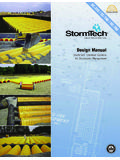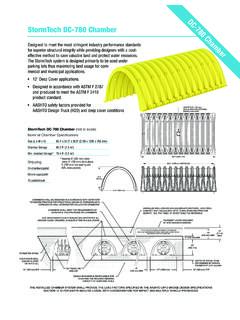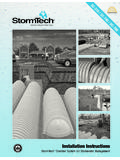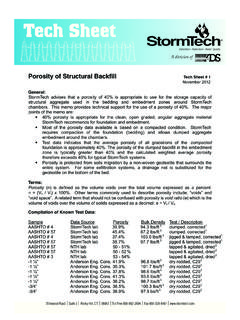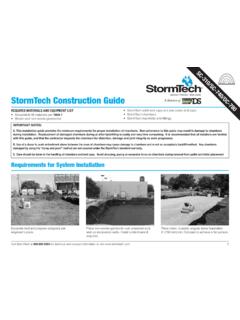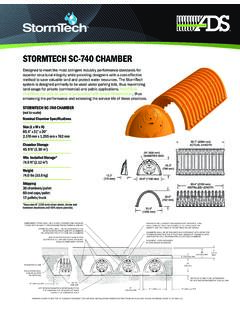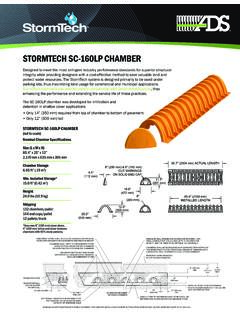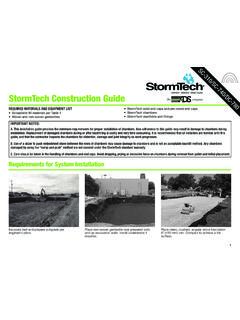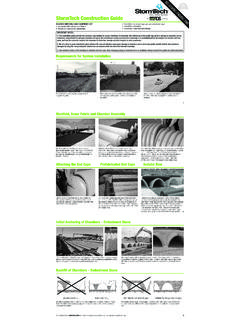Transcription of Stormtech Tech Sheets August11
1 Tech Sheet Detention Retention Water Quality A division of Thermoplastic Liners for Detention Systems Tech Sheet # 2. December, 2012. General: Stormtech chambers offer the distinct advantage and versatility that allow them to be designed as an open bottom detention or retention system. In fact the vast majority of Stormtech installations and designs are open bottom detention systems. Using an open bottom system enables treatment of the storm water through the underlying soils and provides a volume safety factor based on the infiltrative capacity of the underlying soils. In some applications, however, open bottom detention systems may not be allowed. This memo provides guidance for the design and installation of thermoplastic liners for detention systems using Stormtech chambers.
2 The major points of the memo are: Infiltration of stormwater is generally a desirable stormwater management practice, often required by regulations. Lined systems should only be specified where unique site conditions preclude significant infiltration. Thermoplastic liners provide cost effective and viable means to contain stormwater in Stormtech subsurface systems where infiltration is undesirable. PVC and LLDPE are the most cost effective, installed membrane materials. Enhanced puncture resistance from angular aggregate on the water side and from protrusions on the soil side can be achieved by placing a non-woven geotextile on each side of the geomembrane. A sand underlayment in lieu of the geotextile on the soil side may be considered when cost effective.
3 Stormtech does not design, fabricate, sell or install thermoplastic liners. Stormtech recommends consulting with liner professionals for final design and installation advice. Membrane Materials: Polyvinyl chloride (PVC) is an effective liner material for Stormtech systems. PVC offers good chemical resistance to contaminant concentrations typical of highway runoff and to chlorides from road salting applications. Non-reinforced 30 mil PVC liners are recommended for Stormtech systems. PVC is flexible. It can be folded without damage and is typically prefabricated and shipped to the jobsite. Panels as large as 20,000 sq. ft. can be prefabricated into a 4000 lb panel (30 mil is lbs/sq. ft., SG = ). PVC has the versatility to be field solvent welded, taped or field heat welded.
4 A very significant advantage of PVC is that an excavation contractor can install a PVC liner without specialty crews. Solvent welding of seams, patches and pipe boots can all be done by the excavation contractor making PVC the lowest cost liner alternative. The PVC compound includes fillers and plasticizers to reduce cost and UV inhibitors to extend the service life under exposure to sunlight. Under prolonged sunlight exposures such as in a permanent surface pool, these additives can leach into the pool and reach concentrations 70 Inwood Road Suite 3 Rocky Hill, CT 06067 Toll Free 888-892-2694 Fax 866-328-8401 Page 2 of 6. Tech Sheet #2. harmful to aquatic life. PVC compounds referred to as fish safe are sometimes used for surface pond liners and may be considered for Stormtech liners.
5 However, since Stormtech systems are subsurface, there is no opportunity for UV attack by sunlight. Also since stormwater is detained for short durations, typically 48 hours or less, there is little opportunity for accumulation of leachates. Therefore PVC is an excellent membrane material for thermoplastic liner detention systems. Recommended Configuration: 30 mil PVC with 8 ounce non-woven geotextile underlayment and overlayment, open top with high flow bypass. Recommended Restriction: Do not use for fuel spill containment. Linear low density polyethylene (LLDPE) is a very inert material that offers excellent chemical resistance and is fish safe . LLDPE is an effective liner system for Stormtech systems, particularly for small projects where the entire liner can be prefabricated in one piece or when using taped seams.
6 LLDPE is flexible up to 30 mil but thicknesses greater than 30 mil should not be folded without potential damage. 30 mil LLDPE is recommended. Extra care should be taken to protect against puncture. A. minimum 8-ounce non-woven fabric underlayment and 12-ounce overlayment should be specified. The underlayment should be increased to 12-ounce where water tightness is essential and increased puncture risk exists. Panels as large as 27,000 sq. ft. can be prefabricated into a 4000 lb roll (30 mil is lbs/sq. ft.). LLDPE has a specific gravity less than LLDPE seams can be taped or field heat welded. Installation costs may increase if field seaming by a specialty contractor is required. Recommended Configuration: 30 mil LLDPE with 8 ounce non-woven geotextile underlayment and 12-ounce overlayment, open top with high flow bypass.
7 Recommended Restriction: Do not use for fuel spill containment. Reinforced Polypropylene (RPP), EPDM and XR-5 are excellent materials for lining systems due to their flexibility, durability and excellent chemical and UV resistance. Although excellent lining materials, they generally exceed the engineering requirements for typical applications and are higher in cost than PVC or LLDPE. For fuel and oil concentrations normally found in storm water from parking and roadways, PVC, LLDPE and PP are suitable. However, if containment of aggressive contaminants, fuels or fuel spills are anticipated, a liner professional should be consulted. XR-5 in thicknesses of 30 mil or more, with welded seams may be suitable. Polyethylene (PE) materials are generally inert, offer excellent chemical resistance and are fish safe.
8 Although medium density polyethylene (MDPE) liners are widely used for sanitary landfills and fish ponds , they are generally much higher in total cost and are not likely to be cost effective lining materials. High density polyethylene (HDPE) is not flexible enough to resist puncture and conform to the excavation. Cost aside, MDPE is an acceptable liner material for Stormtech systems but should be limited to subgrades that are well prepared, without protrusions and must be field seamed. Page 3 of 6. Tech Sheet #2. Geotextile Materials: 6-ounce AASHTO M288 Class 2 non-woven separation geotextile over the top of stone (ADS 601 or equal). 8-ounce AASHTO M288 Class 2 non-woven geotextile for use as protection layer for PVC, RPP and LLDPE (ADS 801 or equal).
9 12-ounce AREMA Chapter 1 Part 10 Category Regular non-woven geotextile for use as protection layer for LLDPE and other PE membranes (ADS 1201 or equal). Seaming Options: 1. Prefabricated vs. Field Prefabricated seams are preferable to field seams for all liner materials whenever possible. 2. Solvent Welded PVC only, low cost 3. Heat Welded Costly, require trained seamer, for all liner materials 4. Taped Cost effective, M50-RC Gray distributed by Titus Industrial Group recommended, single sided, 4 width, for all liner materials. No water tightness data is available. 5. Overlapped Not water tight, no leakage rates available, suggest 4 ft overlap for all materials. Pipe boots are used to seal pipe penetrations through the liner. Boots can either be prefabricated by the liner fabricator or field fabricated by the contractor.
10 The boot is then solvent cemented, heat welded or taped to the liner. A pipe clamp is normally used to seal the boot around the pipe. Seaming and sealing pipe boots at low temperatures (32 F minimum) requires preheating of the material. Design: General The design of a lined system must be performed by the consulting engineer and, at minimum, requires knowledge of design storage, peak flow rates and maximum seasonal high groundwater elevation. This information is used to design the peak flow control structure, maximum liner height and groundwater control (if necessary). High Flow Bypass A high flow control is an important component for any lined system. The high flow control is designed to pass the peak flow while ensuring that the liner is not overtopped.
